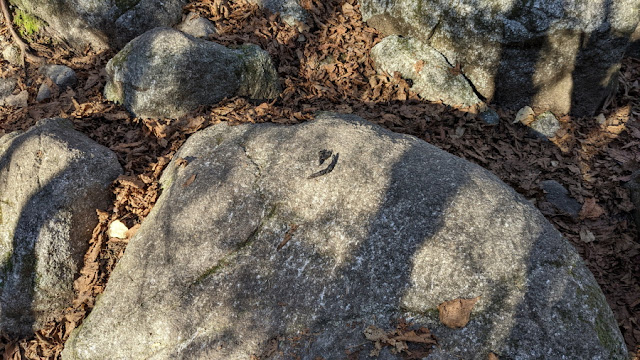Hello November, though it sure doesn't feel like it.
 |
| A warm November day on the lake. |
We've had more good paddling weather and I've been out a couple of times this week to take advantage of it. Though most of the leaves have come down there are still a few bright yellow trees accenting the hills around the lakes.
I wasn't sure what kind of tree was holding on to such bright leaves this long so I took a trip over to Wicwood Shores Road to investigate, and they are in fact bigtooth aspen trees - very large and impressive bigtooth aspen.
 |
| Mature aspen can grow to 60' high |
The only down side of the warm weather is the high water content in the atmosphere brought up from the south with the warm air mass which makes for a lot of haze, particularly looking south with the sun low in the sky.
 |
| Looking south from the summit of Mt. Osceola on Thursday, |
But even looking north towards Canada it was hazy.
 |
| North from the summit. |
It was hard to drag myself off that warm and peaceful spot on our planet, knowing it may well be the last summer hike of the year. There were few people on the trail this late in the hiking season, and even fewer birds to be heard - just a few scolding chickadees and a barely perceptible "pip" of some tiny bird in the trees. But there was one exciting find, evidence of the elusive marten right in the middle of the trail.
 |
| Marten scat deposited on a boulder for all to see. |
Other animals will leave their scat in prominent spots for all to see and smell, including other members of the weasel family, so I had to look this one up. I knew it was a weasel by the twisted form of it, but not which weasel. My go-to reference book, "Tracking and the Art of Seeing" by Paul Rezendes [HarperCollins, 1999] indicated it was left by a Marten.
They definitive factor is the size. Marten scat is 1/4" in diameter and 1-1/2" long, whereas the other likely candidates, the least weasel, long-tailed weasel, or ermine, have scat less than 1/8" in diameter and 1-1/4" in length. Supporting this conclusion is the location, in a mixed forest at an altitude of about 2500' in the White Mountains. In winter this animal may move to higher elevation to take advantage of the dense cover of the spruce-fir forest for dens and hunting. The marten is the rarest of our weasels, having been driven from most of its range by logging and trapping, though recent regulations on trapping have allowed a rebound in its numbers. It's range in New Hampshire is still constrained to the White Mountains and farther north; marten are secretive and reclusive so I don't expect to ever see one.
I didn't see any loons on the lake this week, so I'm interested if anyone has seen them. It doesn't seem like they would have left while the weather is still so nice. The herons certainly haven't left; I've seen them several times this week, fishing, and flying over the lake.
I can't be sure what the heron think, but I'm perfectly happy with 70 degrees in November - as long as it gets cold in time for winter to start, and I know I'm not the only one that likes a quick transition from summer to winter.
I'll end with a couple more scenes that reflect the beauty of the late fall season around the lakes.
 |
| Looking south down Harris Cove. |
 |
| The Rawson Wood Islands from the Red Trail viewpoint in the Hamlin Conservation Area. |




Nice’
ReplyDeleteLove to read your updates. Great pictures, commentary, and entertainment! Thanks for sharing your fun and perspective.
ReplyDeleteAmazing. The art of seeing. Thank you.
ReplyDeleteBeautiful, again.
ReplyDelete